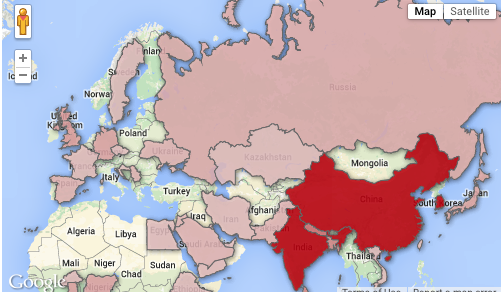
International students adapt to new culture, distance from friends, family
Southeastern South Dakota might not seem like an international crossroads, but at the University of South Dakota, students from around the world are gathering.
Patrick Morrison, international student adviser at the Center for Academic and Global Engagement, said about 240 international students currently attend USD, and China and India are among the most represented countries.
Pedro Frajdrach Chequetti da Rocha is a first-year student from Sao Paulo, Brazil and is studying marketing and communications and minoring in mathematics. Chequetti said his decision to attend USD was influenced by the low expense, the different weather and the security.
“It’s very safe — it’s pretty much safer. You can walk anytime you want in the streets,” Chequetti said. “The stuff in the U.S., it’s cheaper. Life here is easier — a lot easier than in my country.”
Han Suenghee, a transfer student from Seoul, South Korea, is a Criminal Justice major and said expense and location were additional factors he considered.
“It’s very peaceful,” Suenghee said. “The U.S. living prices are cheaper than my country.”
Suenghee said some Asians travel to the U.S. and decide to study there for political reasons.
“It’s quite a serious question,” Suenghee said. “There is two kinds of people. Some people like socialism, and other people like liberty. Actually, (Asia is dominated) by socialism, but some people dislike socialism, and they come to study abroad.”
Suenghee said American culture is very different than the homogenous culture in South Korea.
“There are a lot of people in the U.S., so it’s a very large culture,” Suenghee said.
Chequetti said some hardships include the language barrier, the weather and the distance from home.
“Being away from friends and family, so you need to restart all over again,” Chequetti said. “You need to adapt to the culture, most things are different here than it was. Right here in South Dakota, the cold, because I come from a tropical country, and it never got as cold as here. And food is kind of different.”
While Suenghee said he liked everything about the U.S., Chequetti said he strayed away from American politics.
Morrison said the appeal to international students to study at USD is not so different than it is for a student from the U.S. who chose to come to Vermillion.
“First of all, it’s affordable,” Morrison said. “(It is a) small campus. For some of them, it’s just different than what they’re used to. It’s attractive to international students for all the ways it’s attractive for domestic students. For what would make a student from New York or Chicago or Sioux Falls be interested in USD, it would be the same thing if you were from Paris or Shanghai or Adelaide.”
Morrison said business, computer science and hard sciences are very popular, but international students can be found in just about every program on campus.
“Pretty much any major on campus, I would be surprised if we didn’t have at least one student in there,” Morrison said.
Morrison said most students stay for the full length of their program and have the option to either stay and work in their field of study or return home.
“For the most part, these students are coming here to get a four-year degree, two-year graduate degree or a Ph.D,” Morrison said. “Apart from the compliance things, we try to treat them just like we would a domestic student who walks in the door.”
Morrison said CAGE offers certain services to international students, such as taking them shopping and on trips to other parts of the region and even helps them adapt to the more technical aspects of living in the U.S., such as filing taxes.
However, CAGE is just as happy to help students with something as small as finding a classroom, and that’s what sets USD apart from bigger universities, Morrison said.
“If you take care of the little details — go the extra mile — I think collectively, it makes USD an attractive place for students once they get here,” Morrison said.
In addition to USD’s general rules, there are certain regulations all international students have to follow, Morrison said. For example, students cannot work off-campus and cannot work more than 20 hours per week. This ensures that students are learning and not trying to balance work with their schooling.
Chequetti said while he knows he must return to Brazil, he loves the experience he has had.
“It’s an amazing experience,” Chequetti said. “You’re going to meet a lot of people from all over the world.”
(GRAPHIC: Two-hundred forty international students attend the University of South Dakota. The students represent a total of 49 different countries from around the world. Megan Street / The Volante)

